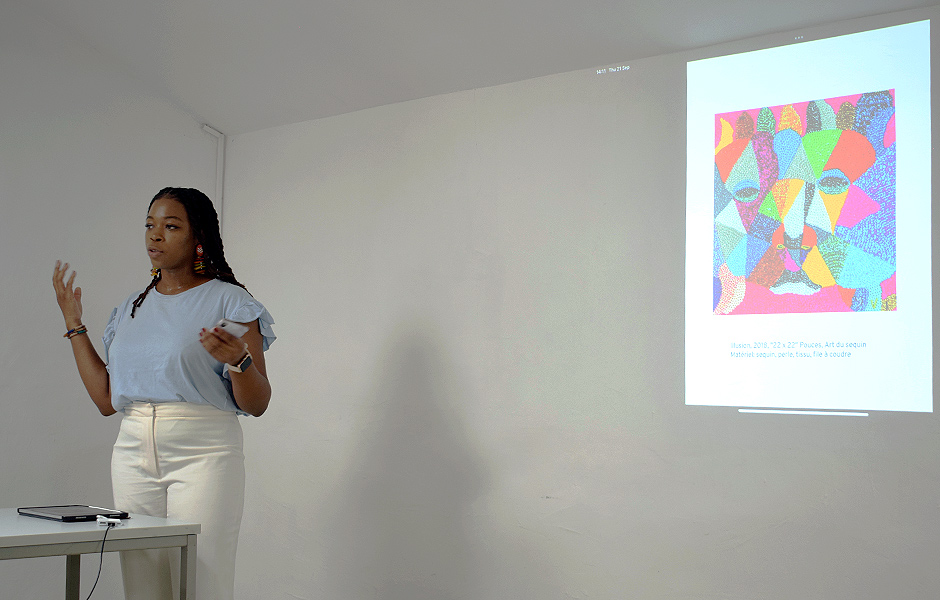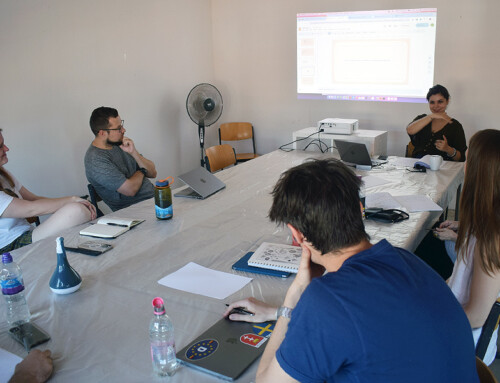September 21, 2023, 2 – 3:30 PM
Many thanks to the artist, executive assistant and women program facilitator Youseline Vital from Haiti introducing our participants to Sequin Art And Contemporary Haitian Art within the Studio Program at BAI | Berlin Artist Residency, Art School, Arts Incubator, and Live Online Courses & Classes. For her fellowship at the Berlin Art Institute Youseline Vital got a scholarship for participating in the CrossCulture Program (CCP) by ifa (Institute for Foreign Cultural Relations). BAI has been her host organization in 2023.
“The sequin art is one of the most important plastic practices or expressions in the Haitian visual universe. It is part of the cultural and religious traditions, from the costume ornaments of the Majòjon of the rara to the ritual objects of the vodou.
The sequin art, also known as “Vodou’s flag” or “Vodou’s flag”, has a rich history in Haiti. These vibrant and complex textile works of art have a profound historical significance. The sequin art has played a vital role in the preservation of Haitian cultural heritage. The tradition of sequin art in Haiti has its roots in African religious practices, in particular those of the Yoruba people of West Africa. Yoruba culture incorporates the use of sacred textiles, often decorated with pearls, shells and sequins, as part of their spiritual rituals. Since Vodou is represented as a syncretic national religion that mixes African, indigenous and Catholic beliefs, glitter flags are used as sacred objects during ceremonies, serving as altars and representing spirits, or “lwa”.
During the colonial period, Vodou artists and practitioners adapted European textiles and decorative elements in the creation of sequin art, which will give over time an artistic mix of African, European and indigenous influences. But the sequin art gained recognition in the mid-twentieth century when it became a distinctive form of Haitian art. Artists such as Clotaire Bazile, Antoine Oleyant, Mirlande Constant and Mireille Delice, played a central role in popularizing the creation of elaborate pearl flags.
Haitian art has evolved through different periods, each characterized by distinct styles, influences and historical contexts. Some key periods of Haitian art include: The indigenous period, the colonial period, naive Art, the Saint-Soleil school, Contemporary art. Each of these periods reflects the historical, cultural and artistic dynamics at different times, highlighting the lasting importance of art as a means of expression, identity and resistance in the country’s history.
In contemporary art and culture in Haiti, several movements and themes have emerged, reflecting the country’s heritage, social issues and global influences: Naive art, the influence of vodou, environmental awareness, mixed techniques and installations, the fusion of the traditional and the modern, international collaboration, artisticism, street art, cultural festivals. Contemporary Haitian culture movements reflect the country’s rich and complex history while addressing current challenges and global influences. Haitian artists continue to play a vital role in expressing the resilience, creativity and aspirations of their society.
And places like: Galerie Monnin, located in Port-au-Prince, Ghetto Biennale: a unique event takes place in the Grand Rue district of Port-au-Prince, where local and international artists collaborate and engage with the community through artistic installations, shows and workshops, Atis Rezistans (Artists in Resistance): Collective of artists working in Grand Rue, known for creating sculptures and assemblies from recycled materials. They address social and political issues through their art, Fosaj Art Center: Located in Jacmel, Fosal Art Center hosts exhibitions, residencies and workshops, supporting emerging artists, Art Center: an art school and an art gallery located in Port-au-Prince, demonstrate the dynamic and evolving nature of contemporary art and culture in Haiti, where artists continue to draw on their unique heritage to create impactful and stimulating works.
Haiti has a dynamic community of contemporary artists who contribute to the world art scene with their unique perspectives and creativity, a few artists from various disciplines: Tessa Mars, Barbara Prézeau-Stephenson, Frantz Zéphirin, Jean-Ulrick Désert, Pascale Monnin, Pierre-Pascal Merizier, Mario Benjamin, Pascale Faublas, Chevelin Pierre, Makseans Denis, Phaidra Sterlin. Haitian art continues to evolve with the arrival of new artists and mediums such as: assembly, recovery, cut iron and wood sculptures, not to mention theater, performance, contemporary dances, scenography and photography. And among which were born artists such as: Kav-Alye Pierre, Février-Fertrude Hugh, Daphena Rémédor, Dieuvela Cherestal, Micaëlle Charles, Gladimy Antoine (Eklips), Schineider Hillaire, Bertho Jean-Pierre, Franscico Silva, Mike Joseph, Victoria Ornelien, Marie Guerlande Balan, Chrisnaïka Derosiers, Kenny Laguerre and many others.
These artists represent only a small part of the diverse and dynamic contemporary art scene in Haiti. They use various mediums and styles to explore complex themes, from identity and spirituality to social justice and global issues, contributing to the rich tapestry of contemporary Haitian art.” (Text by courtesy of Youseline Vital)
Youseline Vital is founder and Chief Creative Officer of Payèt Design, and founder and social media manager of Girlpreneur Ayiti.
“With the CCP Fellowships, the CrossCulture Programme (CCP) funds professionals and committed volunteers from up to 40 countries each year. During two to three months of work-related stays in host organisations in Germany or CCP partner countries, participants deepen their expertise, establish new contacts and acquire intercultural skills. In turn, the host organisations benefit from the expertise, regional knowledge and networks of the CCP Fellows. Participants can also attend transcultural workshops, networking and professional events hosted by the CCP. After returning to their daily working lives, participants then bring the experience they have gained into their home organisation.” (Text by courtesy of ifa)















